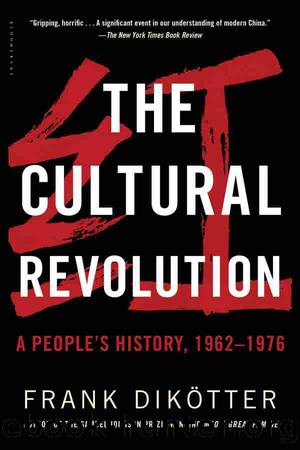The Cultural Revolution by Frank Dikötter

Author:Frank Dikötter
Language: eng
Format: epub
Publisher: Bloomsbury Publishing
Published: 2016-04-15T00:00:00+00:00
The students were not the only ones to be sent to rural areas. As soon as the bamboo curtain came down in 1949, the new regime had started emptying the cities of entire categories of people described as a threat to social order and a drain on public resources. Prostitutes, paupers and pickpockets, as well as millions of refugees and disbanded soldiers, were sent to the countryside, which became the great dumping ground for all undesirable elements. In the intervening years, as the household registration system imposed strict controls on the movement of people, a sometimes deadly game of cat and mouse developed. The most effective strategy for survival in the countryside was to leave the village and migrate to the city. The authorities needed cheap labour, so often they turned a blind eye to the incomers. A vast underclass was created, relegated to dirty, arduous and sometimes dangerous jobs. Migrant workers had no secure status, and risked expulsion back to the countryside at any time. Once in a while, a purge would cleanse the cities of people without proper documentation. Those who were caught were sent back to their villages, while hardened recidivists were dispatched to the gulag.
In 1958, at the height of the Great Leap Forward, as targets for industrial output were ceaselessly revised upwards, more than 15 million villagers moved to the city. But three years later, with the country bankrupt, 20 million people were deported back to the countryside.29
When, on 7 September 1968, Zhou Enlai had announced that students should go up the mountains and down to the villages to learn from the great proletarian masses, he had also urged the party to cleanse the class ranks and âstreamline the administrationâ, sending superfluous staff back to join production in the countryside. Millions of people had used the chaos of the Cultural Revolution to find their way to the city, and now the premier indicated that the time for their deportation had come.30
The scale of the transportations was staggering, by far surpassing what had happened under the Red Guards in the summer of 1966, when nationwide some 400,000 people from bad family backgrounds had been hounded out of the cities. From Shanghai alone, up to 1975, roughly a third of a million people were removed, not including 950,000 students. In some cases, in smaller cities, the number of ordinary people banished to the countryside actually exceeded exiled students by a factor of two to one. In the single county of Lingling, a hilly part of southern Hunan where several rivers converged, 35,000 city dwellers were dispersed throughout the countryside compared to 17,000 students. In Hengyang, there were 30,000 ordinary people in exile, twice as many as banished students. Nine out of ten teetered on the edge of starvation, having to make do with a mere 12 kilos of unhusked grain a month, equivalent to less than 1,000 calories a day, far below the 23 to 26 kilos required to provide 1,700 to 1,900 calories per day, an amount international aid organisations consider the bare minimum for subsistence.
Download
This site does not store any files on its server. We only index and link to content provided by other sites. Please contact the content providers to delete copyright contents if any and email us, we'll remove relevant links or contents immediately.
| Arms Control | Diplomacy |
| Security | Trades & Tariffs |
| Treaties | African |
| Asian | Australian & Oceanian |
| Canadian | Caribbean & Latin American |
| European | Middle Eastern |
| Russian & Former Soviet Union |
The Secret History by Donna Tartt(16681)
The Social Justice Warrior Handbook by Lisa De Pasquale(11496)
Thirteen Reasons Why by Jay Asher(7810)
This Is How You Lose Her by Junot Diaz(5805)
Weapons of Math Destruction by Cathy O'Neil(5058)
Zero to One by Peter Thiel(4841)
The Myth of the Strong Leader by Archie Brown(4797)
Promise Me, Dad by Joe Biden(4462)
Beartown by Fredrik Backman(4447)
How Democracies Die by Steven Levitsky & Daniel Ziblatt(4430)
Stone's Rules by Roger Stone(4427)
The Fire Next Time by James Baldwin(4357)
100 Deadly Skills by Clint Emerson(4095)
A Higher Loyalty: Truth, Lies, and Leadership by James Comey(4045)
Rise and Kill First by Ronen Bergman(4029)
The David Icke Guide to the Global Conspiracy (and how to end it) by David Icke(3900)
The Farm by Tom Rob Smith(3884)
Secrecy World by Jake Bernstein(3793)
The Doomsday Machine by Daniel Ellsberg(3743)
